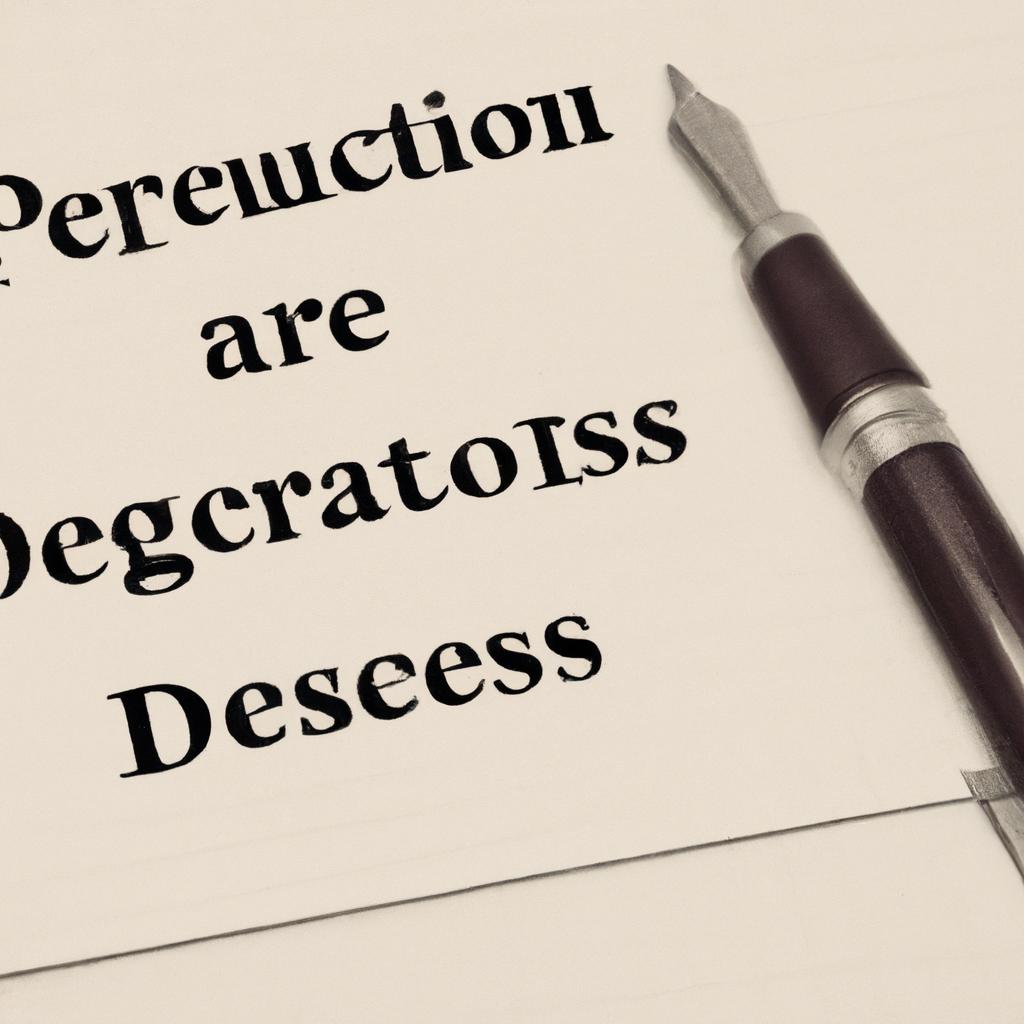In the realm of real estate transactions, the importance of ensuring accurate and legally-binding documentation cannot be understated. One such document, known as a corrective deed, serves as a crucial tool in rectifying errors or omissions in prior deeds. As seasoned legal professionals at Morgan Legal Group in the bustling city of New York, we possess the expertise and precision required to navigate the intricacies of corrective deeds with finesse and efficacy. Join us as we explore a comprehensive example of a corrective deed, shedding light on its significance and the meticulous process involved in its creation.
Understanding the Purpose of Corrective Deeds
is crucial in the real estate industry to rectify any errors or omissions in previously recorded deeds. A corrective deed serves as a legal document that clarifies and corrects any mistakes that may have occurred during the original deed recording process. It is essential to ensure that property ownership and rights are accurately represented to avoid any future disputes.
One common example of a corrective deed is when there are errors in the legal description of the property, such as incorrect lot numbers or boundary lines. By filing a corrective deed, these inaccuracies can be amended to reflect the true and accurate information. Additionally, a corrective deed can be used to add or remove names from the title, update marital status, or correct any spelling errors in the names of the parties involved in the transaction. It is important to consult with a real estate attorney to properly execute a corrective deed and ensure that all legal requirements are met.
| Corrective Deed Example |
|---|
| Correcting errors in legal description |
| Amending property boundaries |
| Adding or removing names from title |

Common Scenarios Requiring Corrective Deeds
When it comes to real estate transactions, there are certain common scenarios that may require the use of corrective deeds to rectify errors or omissions in the original deed. These scenarios can include:
- Misspelled names or incorrect legal descriptions
- Missing signatures or notary acknowledgments
- Errors in the property’s legal description
In these situations, it is essential to file a corrective deed to ensure that the property’s ownership is clear and free of any defects. By executing a corrective deed, the parties involved can correct any mistakes that may exist in the original deed and prevent future legal issues or disputes.
| Scenario | Resolution |
|---|---|
| Misspelled names | Correct the spelling in the deed |
| Missing signatures | Obtain the necessary signatures and notary acknowledgments |
| Errors in legal description | Correct the legal description to accurately reflect the property |

Steps to Take When Drafting a Corrective Deed
When drafting a corrective deed, it is crucial to follow the proper steps to ensure that the document is valid and legally binding. Here are some key steps to take:
<ul>
<li><strong>Identify the error:</strong> Before drafting the corrective deed, it is important to identify the specific error that needs to be corrected in the original deed.</li>
<li><strong>Include a reference:</strong> In the corrective deed, make sure to reference the original deed by including its date, recording information, and any other relevant details.</li>
</ul>
Additionally, it is essential to:
<ul>
<li><strong>Provide a detailed explanation:</strong> Clearly explain the error and the correction being made in the corrective deed to avoid any confusion or ambiguity.</li>
<li><strong>Obtain proper signatures:</strong> All parties involved in the original deed must sign the corrective deed in front of a notary public to ensure its validity.</li>
</ul>

Consulting with an Experienced Real Estate Attorney for Corrective Deed Assistance
When it comes to correcting errors in real estate deeds, consulting with an experienced real estate attorney is crucial to ensure that the process is handled correctly. Corrective deeds are legal documents that can be used to fix mistakes or omissions in previously recorded deeds. These errors can range from typographical errors to missing signatures, inaccurate legal descriptions, or other discrepancies that may affect the title to the property.
At Morgan Legal Group, our team of experienced real estate attorneys can provide you with the guidance and assistance you need to prepare and file a corrective deed. By working with us, you can rest assured that your corrective deed will be accurately prepared and filed, ensuring that the title to your property is free from any defects or issues that could cloud your ownership rights. Don’t leave your property’s title to chance – consult with us today for expert corrective deed assistance.
Q&A
Q: What is a corrective deed?
A: A corrective deed is a legal document that corrects errors or omissions in a previously recorded deed.
Q: Can you provide an example of a corrective deed?
A: Sure! For example, if a deed accidentally misspells a property owner’s name, a corrective deed can be used to make the necessary correction.
Q: Are there any specific requirements for a corrective deed?
A: Corrective deeds typically require the same formalities as the original deed, including signatures from all parties involved and notarization.
Q: When should a corrective deed be used?
A: A corrective deed should be used as soon as an error or omission is discovered in a previously recorded deed to ensure the accuracy of the property’s legal description.
Q: How can a corrective deed be filed?
A: A corrective deed can be filed with the appropriate county recorder’s office where the original deed was recorded.
Q: Is there a cost associated with filing a corrective deed?
A: Yes, there may be a small fee associated with filing a corrective deed, depending on the county recorder’s office.
Insights and Conclusions
In conclusion, corrective deeds serve as a valuable tool for rectifying errors or omissions in property deeds. By providing a practical example of how a corrective deed can be used to effectively address a mistake, we hope to have shed some light on this important legal process. Remember, when it comes to protecting your property rights, it’s always better to be proactive and address any issues promptly. Thank you for taking the time to learn more about corrective deeds.
 Corrective Deed Example: Understanding the Purpose, Process, and Benefits
Corrective Deed Example: Understanding the Purpose, Process, and Benefits
Corrective deeds may not be something that the average homeowner is familiar with, but they can be crucial in certain situations. Simply put, a corrective deed is used to correct errors or omissions in a previous real estate deed. This could be a minor mistake, such as a misspelled name, or a more significant issue, like an incorrect property description.
In this comprehensive guide, we’ll take a closer look at corrective deeds – what they are, when they’re needed, and how to properly complete one. We’ll also provide a real-life example to help you better understand the process. So, whether you’re a property owner looking to correct a mistake or a real estate professional seeking more information for your clients, this article will serve as a helpful resource.
Understanding Corrective Deeds
A corrective deed, also known as a deed of correction, is a document used to correct an issue with a previously recorded real estate deed. It is a legal instrument that serves as an official record of the correction, and it is typically filed with the county or municipal office where the property is located.
There are several reasons why a corrective deed may be necessary. Some of the most common reasons include:
– Errors or typos in the original deed, such as incorrect addresses, misspelled names, or incorrect legal descriptions.
– Omissions in the original deed, such as a missing signature or incorrect property boundaries.
– Changes in ownership or interests, such as a marriage or divorce, that require updating the deed.
– Updating the legal description of the property to match recent surveys or other official documents.
Regardless of the reason, completing a corrective deed is a straightforward process that can help ensure the accuracy and completeness of your property’s legal records.
The Corrective Deed Process
If you find that your property’s deed contains an error or omission, it’s essential to address it promptly. The first step is to determine if a corrective deed is the appropriate solution. While some minor errors can be corrected with a simple affidavit, more significant issues will require a corrective deed to be filed.
Once you’ve determined that a corrective deed is needed, you’ll need to gather the necessary information and documentations. This may include the original deed, the error or omission to be corrected, and any supporting documentation, such as a new survey or legal descriptions.
Next, you’ll need to draft the corrective deed. This can be done by using a pre-printed form available from the county recorder’s office or by hiring an attorney to draft one for you. You’ll want to make sure that the correct property information and details of the error or omission are accurately reflected in the new deed.
Once the deed is drafted, it will need to be signed and notarized by all parties involved in the original deed. This typically includes the property owners and any witnesses to the original deed. It’s essential to follow the proper notarization process for your state or jurisdiction to ensure the deed is legally valid.
After the deed is signed, it will need to be filed with the county or municipal office in the same manner as an original deed. Be prepared to pay any applicable filing fees, which may vary depending on your location.
Example of a Corrective Deed
To better understand the corrective deed process, let’s look at an example.
John and Mary Smith purchased a property together and had a deed recorded in their names. However, when checking the deed, they noticed that Mary’s last name was misspelled as “Smoth.” As this was a significant error, they needed to file a corrective deed.
After obtaining a pre-printed corrective deed form from their county recorder’s office, they filled it out, stating the error and correcting Mary’s name to “Smith.” They then had the deed signed and notarized by both of them, as well as a witness to the original deed.
The Smiths then filed the corrective deed with the county recorder’s office and paid the necessary fees. The deed was recorded, and the error was officially corrected.
Benefits of Completing a Corrective Deed
There are several benefits to completing a corrective deed, including:
– Avoiding potential legal issues: An incomplete or incorrect deed can lead to ownership disputes, title issues, and other legal problems. By correcting any errors or omissions, you can help ensure that you have a clear title to your property.
– Updating property records: As properties change hands and land surveys are updated, it’s essential to keep the property’s legal description accurate and up to date. A corrective deed allows you to do just that.
– Providing clarity for future transactions: When an accurate and complete chain of title is maintained, future buyers or lenders will have confidence in the property’s legal records. This can help make future real estate transactions smoother and more efficient.
Conclusion
Corrective deeds may seem complicated, but they are a necessary tool in maintaining the accuracy and completeness of a property’s legal records. By understanding what they are, when they’re needed, and how to complete one, you can ensure that your property’s deeds remain up to date and legally valid.
If you’re unsure if a corrective deed is the appropriate solution for an issue with your property’s deed, it’s always best to consult with a real estate attorney or other legal professional. They can provide guidance and ensure that the corrective deed is accurately completed and legally binding.

